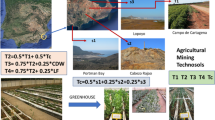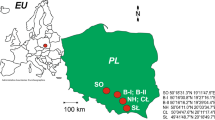Abstract
Understanding metal bioavailability of plants in soils requires, apart from physiological processes and symbiosis with arbuscular mycorrhizal fungi, the consideration of the chemical availability in the soil solution (the intensity of the toxic exposure) and the soil's capacity to supply the metal (capacity). In this contribution we report on the time-dependent accumulation of As, Cd, Cr, Cu, Ni, Pb, and Zn in lettuce (Lactuca sativa L.). Bioassays with 17 Dutch field soils and two artificially metal-contaminated soils were carried out. Phytotoxicity was observed in soils with pH (pore water) <4.8. Metal uptake is shown to be both metal- and soil-dependent and strongly depends on the amount of water the plant transpired and the available concentration in the water. No net accumulation of As, Pb, Ni, and especially Cr was observed in most soils tested. The latter observation is in agreement with findings of Zayed et al. (Planta, 1998 206:293–299), who reported that translocation of Cr from roots to shoots is extremely limited. Internal Cd levels in the plants varied greatly among soils, whereas plant tissue concentrations of Zn and especially Cu appear to be regulated at more or less fixed levels. The 0.01 M CaCl2-extractable metal pool provides the best descriptor for the capacity of the soil to supply Cd and Zn. This enabled the development of models that are suited to predict Zn and Cd uptake by lettuce in both field soils (weathered soils) and soils to which metal salts were added, which is common practice in toxicity testing of chemicals. It is concluded that of all metals included in this study, Cd is the metal of most concern due to bioaccumulation through the soil-plant-animal food chain as Cd is the only metal that might pose human or animal health risks at plant tissue concentrations that are not directly phytotoxic. Finally, application of the models for risk assessment purposes is discussed.
Similar content being viewed by others
Explore related subjects
Discover the latest articles and news from researchers in related subjects, suggested using machine learning.Author information
Authors and Affiliations
Additional information
Received: 14 February 2000/Accepted: 9 July 2000
Rights and permissions
About this article
Cite this article
Peijnenburg, W., Baerselman, R., de Groot, A. et al. Quantification of Metal Bioavailability for Lettuce (Lactuca sativa L.) in Field Soils. Arch. Environ. Contam. Toxicol. 39, 420–430 (2000). https://doi.org/10.1007/s002440010123
Published:
Issue Date:
DOI: https://doi.org/10.1007/s002440010123




